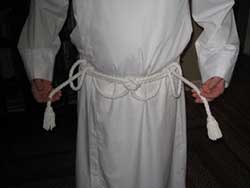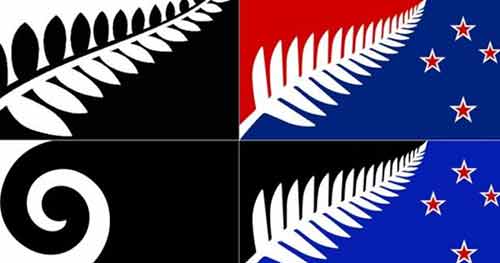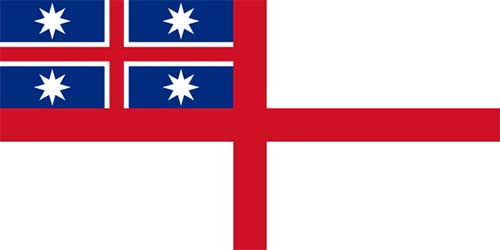

I’m afraid that my response, “they mean that you don’t end up tripping up over the cord,” didn’t satisfy this person.
Something completely made up, like: “one knot represents the divinity of Christ, the other the humanity of Christ, and the cincture joins the two together”, would have been much more to this person’s liking.
There is something in our English/Anglican/Kiwi psyche that grasps quickly onto the shallow answers of allegory. No need to go deeper. Question answered. The bread means this. And only this. The candle represents that. And only that. This robe signifies this. And only this. Next question.
I’ve seen it in New Zealand’s flag “debate”. We’ve ended up with four options to vote on that are easily explained. This means this. That means that. Flag done.

There’s nothing wrong with allegory, of course, if depth is not being sought. CS Lewis loathed his Narnia books being described as allegory. He saw them as the Christian story being retold in a fantasy world. Logos for businesses need only be at the level of allegory. Prime Minister John Key regularly speaks of New Zealand as a brand. A flag for brand New Zealand, then, is to be a logo that will increase our brand recognition. And sales.

New Zealanders will choose from one of the four options (above) in a first referendum, and then the winner of that will be run off against the current flag in a second referendum. Mathematicians, following choice architecture (aka behavioral economics or nudge theory) predict the black-and-white fern design (the one closest to John Key’s original wish) will win the first vote. Successful businessman John Key will be well-aware of this oft-used advertising/business approach. The Hypnoflag is so bad it makes the others look OK. Then those who like the fern and stars will split that vote, and the one closest to John Key’s original wish will come up the middle.
But there is another dynamic. Those who want to retain the current flag may go out in droves and vote for the Hypnoflag knowing that should that win, it will inevitably lose against the current flag.




There is something in our English/Anglican/Kiwi psyche that grasps quickly onto the shallow answers of allegory.
…except this is not allegory at all. What you describe is semiotics – using one thing to point directly to another. Allegory doesn’t point; it suggests.
Aslan is not Jesus Christ: he is Aslan (there is no Trinitarian theology in Narnia for one thing) – but his character and traits make many people think of Jesus. You could say the same of MLK, or Valjean from Les Miserables.
Churches don’t like allegory, because to get it, people have to think for themselves. The semiotics of how many buttons on the cassock, how wide you hold your hands when consecrating the bread, stuff like that, is ultimately controllable and leaves you with a flock of dumb but biddable sheep – which is the purpose of the exercise, no?
(Oh, and where’s the sheep on your flag designs?)
Well pointed out James. And, I wondered for years, as I prepared for the Mass, how often Jesus would have gone through all that fiddly preparation. The simple preparations of ensuring clean vestments and clean hands appears to be lost. Have you noticed how many clergy turn up for big gatherings carrying their albs and stoles in a New World carrier bag. There’s a metaphor there, somewhere. Or is that allegorical?
If I had to choose one of the four, I like the red & blue stars & fern.
a few weeks ago I chose a different one of the original released possibilities.
http://www.episcopalcafe.com/the-maori-cultural-stream-of-the-anglican-church-in-aotearoa-new-zealand-and-polynesia-meets-in-the-city-of-wellington/
However, I have more thought of a national flag as a symbol than an allegory.
I like the red peak flag.
How boring the Anglican Christian community must be when everything liturgical is getting so purely functional. For Catholic orders, the most common number of knots used are 3 traditionally sybolising poverty, chastity and obedience. 5 symbolises the 5 wounds of Christ and 7 symbolises the gifts of the Holy Spirit. Among some religious orders, particularly of the women religious, 7 knots also symbolises the 7 sorrows of Mary while for others the 7 joys/sorrows of St Joseph. The language of liturgical symbolism is the language of the spirit which Anglicans do not seem to understand anymore, it seems.
Quite the opposite, I’m afraid, Ted, is the intent of this post, and the understanding of symbolism on this site. I’m sorry if that is not being made clear. I encourage you to read more widely on this site, including the introductory video and the online free book, Celebrating Eucharist. Your comment is praising the very thing I am advocating one goes deeper than – grasping “quickly onto the shallow answers of allegory. No need to go deeper.” I am encouraging allowing symbols to speak to us deeply, in a multivalent manner – rather than flattening our symbolism to mean this and only this. The language of liturgical symbolism is certainly the language of the spirit, but that language is not 5 knots = 5 wounds of Christ; 7 knots = 7 gifts of the Holy Spirit. Blessings.
Not to mention that there are Christians who believe that there were 7 wounds of Christ. The nail in the sure place!
Symbolism in both Anglican and most Catholic worship has, sadly, become an unnecessary evil. The dumbing down of most everything to the lowest common denominator has reduced liturgy to a level of drabness comparable only to Cromwellian Britain. Are we in danger of returning to another Puritan age?